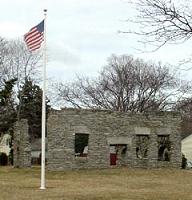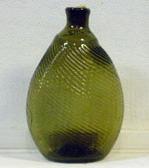Pitkin Glass Works
Located at the intersection of Parker and Putnam Streets in the Manchester Green area
 In 1783, Connecticut's General Assembly granted Captain Richard Pitkin and his sons a 25-year monopoly on manufacturing
glass, as recompense for their providing gun powder, at a loss, to the Connecticut militia, 1775-1781. The Pitkin Glass
Works, the first successful glass factory in Connecticut, was built in Manchester (then the Orford Parish of East Hartford)
on the Pitkin farm, now on the corner of Putnam and Parker Streets. Remaining in operation until about 1830, the factory
produced demijohns for the West Indian trade, and bottles, flasks, inkwells and other small items, mostly in shades of
green. These were considered to be the best color and design in the country. Rare today, Pitkin flasks have brought tens
of thousands of dollars at auctions.
In 1783, Connecticut's General Assembly granted Captain Richard Pitkin and his sons a 25-year monopoly on manufacturing
glass, as recompense for their providing gun powder, at a loss, to the Connecticut militia, 1775-1781. The Pitkin Glass
Works, the first successful glass factory in Connecticut, was built in Manchester (then the Orford Parish of East Hartford)
on the Pitkin farm, now on the corner of Putnam and Parker Streets. Remaining in operation until about 1830, the factory
produced demijohns for the West Indian trade, and bottles, flasks, inkwells and other small items, mostly in shades of
green. These were considered to be the best color and design in the country. Rare today, Pitkin flasks have brought tens
of thousands of dollars at auctions.
It is not known why the factory was closed down. Perhaps it was because of the cost of transporting sand from New Jersey, or because the firewood supply was decreasing with the growth of farming in the area. There may have been poor management, or increasing competition from other factories once the monopoly expired. Gradually, the massive stone building fell into disrepair.
In 1928, Mr. And Mrs. Fred W. Pitkin and others of the Horace Pitkin family quit-claimed the property to the Orford Parish Chapter of the Daughters of the American Revolution. Finding the cost of maintenance a burden, a suggestion was made in 1977 that it be sold for commercial purposes.
A group of interested citizens, led by Mr. Edson Bailey, protested this possibility, and formed a committee to preserve this historic site for the community.
 Pitkin Glass Works Inc. (the Corporation) was organized, with executive officers, and five representatives from the Orford
Parish Chapter of the Daughters of the American Revolution; five representatives from the Manchester Historical Society,
Inc.; and five representatives from the citizenry at large. Papers were filed for incorporation, and by-laws were drawn up.
The site was approved for inclusion on the National Register of Historic Places.
Pitkin Glass Works Inc. (the Corporation) was organized, with executive officers, and five representatives from the Orford
Parish Chapter of the Daughters of the American Revolution; five representatives from the Manchester Historical Society,
Inc.; and five representatives from the citizenry at large. Papers were filed for incorporation, and by-laws were drawn up.
The site was approved for inclusion on the National Register of Historic Places.
Since then, the Corporation has overseen the landscaping of the area, and installed a flagpole with a flag that has flown over our national capitol. The monumental stone ruins have been stabilized by repointing the stonework and replacing the wood lintels.
In the 1980s, students from Central Connecticut State University made a preliminary archaeological dig, but only shards of glass and pottery were found. In recent years, several archaeological digs have been carried out by middle school, high school and university students under the direction of the state archaeologist.* Numerous pieces of bottles, flasks and inkwells have been discovered and cataloged. The fragments have confirmed the characteristics of the products made here.
All the funds to support the work of the Corporation have been raised by the generosity of private benefactors, or through the sale of replicas of a Pitkin flask and an inkwell, and pendants made from fragments of glass. An illustrated hard-cover book by Dr. William E. Buckley, "A History of the Pitkin Glass Works," has also been published.
The Corporation remains active, carrying out its mandate to maintain and preserve this part of our heritage for future
generations.
For additional information on the Pitkin Glass Works, visit their web site Pitkin Glass Works web site. A map and additional information available on the Museum of Connecticut Glass web site Pitkin Glass page on Museum of CT Glass web site.
*To read a reprint of an article on an archaeological dig at the Pitkin Glass Works,
carried out in May, 2012, click here.
